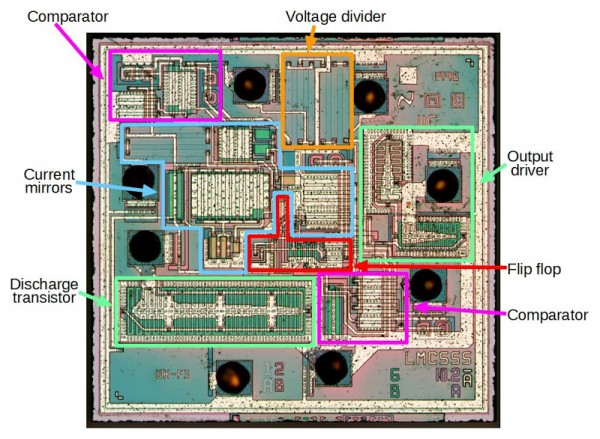Reverse engineering the popular 555 timer chip (CMOS version)
The structure of the integrated circuit
The photo below shows the silicon die of the LMC555 as seen through a microscope, with the main function blocks labeled (photo from Zeptobars). The die is very small, just over 1mm square. The large black circles are connections between the chip and its external pins. A thin layer of metal connects different parts of the chip. This metal is clearly visible in the photo as white lines and regions. The different types of silicon on the chip appear as different colors. Regions of the chip are treated (doped) with impurities to change the electrical properties of the silicon. N-type silicon has an excess of electrons (making it Negative), while P-type silicon lacks electrons (making it Positive). On top of the silicon, polysilicon wiring shows up as other colors. The silicon regions and polysilicon are the building blocks of the chip, forming transistors and resistors, which are connected by the metal layer.
A brief explanation of the 555 timer
The 555 chip is extremely versatile with hundreds of applications from a timer or latch to a voltage-controlled oscillator or modulator. To explain the chip, I will use one of the simplest circuits, an oscillator that cycles on and off at a fixed frequency.The diagram below illustrates the internal operation of the 555 timer used as an oscillator. An external capacitor is repeatedly charged and discharged to produce the oscillation. Inside the 555 chip, three resistors form a divider generating reference voltages of 1/3 and 2/3 of the supply voltage. The external capacitor will charge and discharge between these limits, producing an oscillation, as shown on the left. In more detail, the capacitor will slowly charge (A) through the external resistors until its voltage hits the 2/3 reference. At that point (B), the threshold (upper) comparator switches the flip flop off turning the output off. This turns on the discharge transistor, slowly discharging the capacitor (C) through the resistor. When the voltage on the capacitor hits the 1/3 reference (D), the trigger (lower) comparator turns on, setting the flip flop and the output on, and the cycle repeats. The values of the resistors and capacitor control the timing, from microseconds to hours.
To summarize, the key components inside the 555 timer are the comparators to detect the upper and lower voltage limits, the three-resistor divider to set these limits, the flip flop to keep track of whether the circuit is charging or discharging, and the discharge transistor. The 555 timer has two other pins (reset and control voltage) that I haven't covered above; they are used in more complex circuits.
Transistors inside the IC
Like most integrated circuits, the CMOS 555 timer chip is built from two types of transistors, PMOS and NMOS. In contrast, the classic 555 timer uses the older technology of bipolar transistors (NPN and PNP). CMOS is popular because it uses much less power than bipolar. CMOS transistors be packed into a chip very densely without overheating, which is why CMOS has ruled the microprocessor market since the 1980s. Although the 555 doesn't require many transistors, low power consumption is still an advantage.
The diagram below shows an NMOS transistor in the chip, with a cross section below. Since the transistor is built from overlapping layers, the die photo is a bit tricky to understand, but the cross section should help clarify it. The different colors in the silicon indicate regions that has been doped to form N and P regions. The green rectangle is polysilicon, a layer above the silicon. The whitish rectangle is the metal layer on top. The vias are connections between the layers.
A MOS transistor can be thought of as a switch that connects or disconnects the source and drain, based on the voltage on the gate. The transistor consists of two rectangular strips of silicon that has been doped negative (N), embedded in the underlying P silicon. The gate consists of a layer of conductive polysilicon above and between the drain and source. The gate is separated from the underlying silicon by a very thin layer of insulating oxide. If voltage is applied to the gate, it produces an electric field that changes the properties of the silicon below the gate, allowing current to flow.[2] The photo also shows the metal connection to the source, along with the “vias” that connect the silicon layer to the metal layer through the insulating oxide.[3]
The second type of transistor is PMOS, shown below. PMOS transistors are opposite to NMOS in many ways; they are called complementary, which is the C in CMOS. PMOS uses a source and drain of P-doped silicon embedded in N-doped silicon. The transistor is turned on by a low voltage on the gate (opposite to NMOS), causing current to flow from the source to drain. The metal connections to the source, gate, and drain are visible below, with circular vias to the underlying layers. (Note that the diagram on the right is not a cross section, but a simplified “overhead” view.) In the die photo, NMOS transistors are blue with a green gate, while PMOS transistors are pink with orange gates. These colors are created by interference due to the thickness of the layers, and saturation is enhanced in the photo.
For more detail: Reverse engineering the popular 555 timer chip


